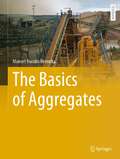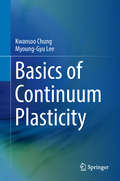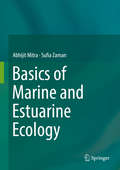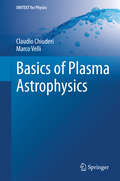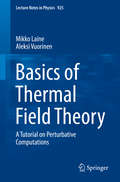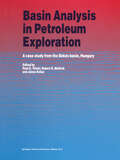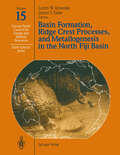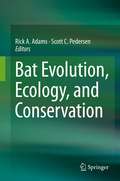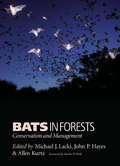- Table View
- List View
The Basics of Aggregates (Springer Textbooks in Earth Sciences, Geography and Environment)
by Manuel Bustillo RevueltaAggregates are among the most common natural resource used in everyday's life, having enhanced life quality. They are essential for construction, being utilized in nearly all residential, commercial, and industrial building construction and most public work projects such as roads, highways and bridges, railroad beds, dams, airports, tunnels, and many others. In the future, the rebuilding of deteriorated roads, highways, bridges, airports, seaports, and private and public buildings will require vast amounts of aggregate. Although it is almost impracticable to know the total amount of aggregates extracted every year globally, it is roughly estimated that annual aggregate production totals about 25 billion tons. Both developed and developing nations require extensive use of aggregates.The book "The Basics of Aggregates" covers all topics related to utilizing this type of material, including the properties of aggregates, types of deposits, geological occurrence, exploration methodologies and extraction methods, and processing techniques as well as their main applications and the importance of recycled aggregates. It serves as a basic text on aggregates for natural sciences and provides information about the main aggregate materials comprehensively with extensive number of illustrations and equips students to handle the mining cycle of aggregates. It enhances the understanding of the different aggregate types, being interdisciplinary and practice-oriented. This textbook addresses bachelor and master students of geology and general earth science as well as students of engineering and environmental sciences. It is written for undergraduate and graduate students, researches and professionals alike.
Basics of Atmospheric Dynamics
by R.N. KeshavamurtyThe book discusses the basic of atmospheric dynamics where the curved surface of the earth and its rotation around its own axis plays very important roles. The emphasis is on basic physical concepts and the interpretation of equations and the different terms therein. Note: T&F does not sell or distribute the hardback in India, Pakistan, Nepal, Bhutan, Bangladesh and Sri Lanka.
Basics of Atmospheric Dynamics
by R.N. KeshavamurtyThe book discusses the basic of atmospheric dynamics where the curved surface of the earth and its rotation around its own axis plays very important roles. The emphasis is on basic physical concepts and the interpretation of equations and the different terms therein. Note: T&F does not sell or distribute the hardback in India, Pakistan, Nepal, Bhutan, Bangladesh and Sri Lanka.
Basics of Continuum Plasticity
by Kwansoo Chung Myoung-Gyu LeeThis book describes the basic principles of plasticity for students and engineers who wish to perform plasticity analyses in their professional lives, and provides an introduction to the application of plasticity theories and basic continuum mechanics in metal forming processes. This book consists of three parts. The first part deals with the characteristics of plasticity and instability under simple tension or compression and plasticity in beam bending and torsion. The second part is designed to provide the basic principles of continuum mechanics, and the last part presents an extension of one-dimensional plasticity to general three-dimensional laws based on the fundamentals of continuum mechanics. Though most parts of the book are written in the context of general plasticity, the last two chapters are specifically devoted to sheet metal forming applications. The homework problems included are designed to reinforce understanding of the concepts involved. This book may be used as a textbook for a one semester course lasting fourteen weeks or longer. This book is intended to be self-sufficient such that readers can study it independently without taking another formal course. However, there are some prerequisites before starting this book, which include a course on engineering mathematics and an introductory course on solid mechanics.
Basics of Environmental Science
by Michael AllabyThe new edition of this popular student text offers an engaging introduction to environmental study. It covers the entire breadth of the environmental sciences, providing concise, non-technical explanations of physical processes and systems and the effects of human activities. In this second edition the scientific background to major environmental issues is clearly explained. These include:* global warming* genetically modified foods* desertification* acid rain* deforestation* human population growth * depleting resources* nuclear power generation* descriptions of the 10 major biomes. Special student text features include illustrations and explanatory diagrams, boxed case studies, concepts and definitions.
Basics of Environmental Science
by Michael AllabyThe new edition of this popular student text offers an engaging introduction to environmental study. It covers the entire breadth of the environmental sciences, providing concise, non-technical explanations of physical processes and systems and the effects of human activities. In this second edition the scientific background to major environmental issues is clearly explained. These include:* global warming* genetically modified foods* desertification* acid rain* deforestation* human population growth * depleting resources* nuclear power generation* descriptions of the 10 major biomes. Special student text features include illustrations and explanatory diagrams, boxed case studies, concepts and definitions.
Basics of Geomatics
by Mario A. GomarascaGeomatics is a neologism, the use of which is becoming increasingly widespread, even if it is not still universally accepted. It includes several disciplines and te- niques for the study of the Earth’s surface and its environments, and computer science plays a decisive role. A more meaningful and appropriate expression is G- spatial Information or GeoInformation. Geo-spatial Information embeds topography in its more modern forms (measurements with electronic instrumentation, sophisticated techniques of data analysis and network compensation, global satellite positioning techniques, laser scanning, etc.), analytical and digital photogrammetry, satellite and airborne remote sensing, numerical cartography, geographical information systems, decision support systems, WebGIS, etc. These specialized elds are intimately interrelated in terms of both the basic science and the results pursued: rigid separation does not allow us to discover several common aspects and the fundamental importance assumed in a search for solutions in the complex survey context. The objective pursued by Mario A. Gomarasca, one that is only apparently modest, is to publish an integrated text on the surveying theme, containing simple and comprehensible concepts relevant to experts in Geo-spatial Information and/or speci cally in one of the disciplines that compose it. At the same time, the book is rigorous and synthetic, describing with precision the main instruments and methods connected to the multiple techniques available today.
The Basics of Geomorphology: Key Concepts (PDF)
by John Lewin Kenneth J. Gregory"I can think of no better guides than Professors Ken Gregory and John Lewin to lead the reader through the conceptual basis of this exciting science." - Victor R. Baker, University of Arizona "A very readable and informative introduction to the discipline for senior undergraduates, postgraduates and researchers." - Angela Gurnell, Queen Mary University of London "Time will tell, but this book may well mark a turning point in the way students and scientists alike perceive Earth surface processes and landforms." - Jonathan Phillips, University of Kentucky This student focused book provides a detailed description and analysis of the key concepts, ideas, and hypotheses that inform geomorphology. Kenneth Gregory and John Lewin explain the basics of landform science in 20 concepts, each the subject of a substantive, cross-referenced entry. They use the idea of the 'geomorphic system' to organise entries in four sections, with extensive web resources provided for each: System Contexts: The Systems Approach / Uniformitarianism / Landform / Form, Process and Materials / Equilibrium / Complexity and Non Linear Dynamical Systems System Functioning: Cycles and cascades / Force-Resistance / Geomorphic work / Process Form Models System Adjustments: Timescales / Forcings / Change Trajectories / Inheritance and Sensitivity / Anthropocene Drivers for the Future: Geomorphic Hazards / Geomorphic Engineering / Design and Prediction Aligned with the teaching literature, this innovative text provides a fully-functioning learning environment for study, revision, and even self-directed research for both undergraduate and postgraduate students of geomorphology.
The Basics of Geomorphology: Key Concepts
by John Lewin Kenneth J. Gregory"I can think of no better guides than Professors Ken Gregory and John Lewin to lead the reader through the conceptual basis of this exciting science." - Victor R. Baker, University of Arizona "A very readable and informative introduction to the discipline for senior undergraduates, postgraduates and researchers." - Angela Gurnell, Queen Mary University of London "Time will tell, but this book may well mark a turning point in the way students and scientists alike perceive Earth surface processes and landforms." - Jonathan Phillips, University of Kentucky This student focused book provides a detailed description and analysis of the key concepts, ideas, and hypotheses that inform geomorphology. Kenneth Gregory and John Lewin explain the basics of landform science in 20 concepts, each the subject of a substantive, cross-referenced entry. They use the idea of the 'geomorphic system' to organise entries in four sections, with extensive web resources provided for each: System Contexts: The Systems Approach / Uniformitarianism / Landform / Form, Process and Materials / Equilibrium / Complexity and Non Linear Dynamical Systems System Functioning: Cycles and cascades / Force-Resistance / Geomorphic work / Process Form Models System Adjustments: Timescales / Forcings / Change Trajectories / Inheritance and Sensitivity / Anthropocene Drivers for the Future: Geomorphic Hazards / Geomorphic Engineering / Design and Prediction Aligned with the teaching literature, this innovative text provides a fully-functioning learning environment for study, revision, and even self-directed research for both undergraduate and postgraduate students of geomorphology.
Basics of Marine and Estuarine Ecology
by Abhijit Mitra Sufia ZamanThe book presents recent research on marine ecology in different parts of the world. It aims to shed light on relevant topics for budding marine ecologists.The “blue soup” of Planet Earth, which comprises both biotic and abiotic components, is essential to keeping the wheel of civilization running. Four major ecosystem service categories have been identified within this context, namely provisioning services such as water, food, mangrove timber, honey, fish, wax, fuel wood, fodder and bioactive compounds from marine and estuarine flora and fauna; regulating services such as the regulation of climate, coastal erosion, coral bleaching and pollution; cultural services encompassing recreational (tourism), spiritual and other non-material benefits; and supporting services such as nutrient cycling and photosynthesis. These valuable services are obtained from various resources that must be conserved for the sake of humanity. This book presents data for each resource type, not just in the form of a simple description, but also through case studies that resulted from several research projects and pilot programs carried out in different parts of the world. Statistical tools were also used to critically analyze the influence of relevant hydrological parameters on the biotic community. Advanced research in marine and estuarine ecology is based on the use of sophisticated instruments, sampling precision, statistical tools, etc., which have also been highlighted in the book.
Basics of Plasma Astrophysics (UNITEXT for Physics)
by Claudio Chiuderi Marco VelliThis book is an introduction to contemporary plasma physics that discusses the most relevant recent advances in the field and covers a careful choice of applications to various branches of astrophysics and space science. The purpose of the book is to allow the student to master the basic concepts of plasma physics and to bring him or her up to date in a number of relevant areas of current research. Topics covered include orbit theory, kinetic theory, fluid models, magnetohydrodynamics, MHD turbulence, instabilities, discontinuities, and magnetic reconnection. Some prior knowledge of classical physics is required, in particular fluid mechanics, statistical physics, and electrodynamics. The mathematical developments are self-contained and explicitly detailed in the text. A number of exercises are provided at the end of each chapter, together with suggestions and solutions.
Basics of Thermal Field Theory: A Tutorial on Perturbative Computations (Lecture Notes in Physics #925)
by Mikko Laine Aleksi VuorinenThis book presents thermal field theory techniques, which can be applied in both cosmology and the theoretical description of the QCD plasma generated in heavy-ion collision experiments. It focuses on gauge interactions (whether weak or strong), which are essential in both contexts. As well as the many differences in the physics questions posed and in the microscopic forces playing a central role, the authors also explain the similarities and the techniques, such as the resummations, that are needed for developing a formally consistent perturbative expansion. The formalism is developed step by step, starting from quantum mechanics; introducing scalar, fermionic and gauge fields; describing the issues of infrared divergences; resummations and effective field theories; and incorporating systems with finite chemical potentials. With this machinery in place, the important class of real-time (dynamic) observables is treated in some detail. This is followed by an overview of a number of applications, ranging from the study of phase transitions and particle production rate computations, to the concept of transport and damping coefficients that play a ubiquitous role in current developments. The book serves as a self-contained textbook on relativistic thermal field theory for undergraduate and graduate students of theoretical high-energy physics.
Basin Analysis: Principles and Application to Petroleum Play Assessment
by Philip A. Allen John R. AllenBasin Analysis is an advanced undergraduate and postgraduate text aimed at understanding sedimentary basins as geodynamic entities. The rationale of the book is that knowledge of the basic principles of the thermo-mechanical behaviour of the lithosphere, the dynamics of the mantle, and the functioning of sediment routing systems provides a sound background for studying sedimentary basins, and is a pre-requisite for the exploitation of resources contained in their sedimentary rocks. The third edition incorporates new developments in the burgeoning field of basin analysis while retaining the successful structure and overall philosophy of the first two editions. The text is divided into 4 parts that establish the geodynamical environment for sedimentary basins and the physical state of the lithosphere, followed by a coverage of the mechanics of basin formation, an integrated analysis of the controls on the basin-fill and its burial and thermal history, and concludes with an application of basin analysis principles in petroleum play assessment, including a discussion of unconventional hydrocarbon plays. The text is richly supplemented by Appendices providing mathematical derivations of a wide range of processes affecting the formation of basins and their sedimentary fills. Many of these Appendices include practical exercises that give the reader hands-on experience of quantitative solutions to important basin analysis processes. Now in full colour and a larger format, this third edition is a comprehensive update and expansion of the previous editions, and represents a rigorous yet accessible guide to problem solving in this most integrative of geoscientific disciplines. Additional resources for this book can be found at: www.wiley.com/go/allen/basinanalysis.
Basin Analysis: Principles and Applications
by Philip A. Allen John R. AllenBasin Analysis is an up-to-date overview of the essential processes of the formation and evolution of sedimentary basins, and their implications for the development of hydrocarbon resources. The new edition features: A consideration of the fundamental physical state of the lithosphere. A discussion on the major types of lithospheric deformation relevant to basin development – stretching and flexure. A new chapter on the effects of mantle dynamics. Radically revised chapters on the basin-fill. A new chapter on the erosional engine for sediment delivery to basins, reflecting the massive and exciting advances in this area in the last decade. Expansion of the techniques used in approaching problems in basin analysis. Updated chapters on subsidence analysis and measurements of thermal maturity of organic and non-organic components of the basin-fill. New material on thermochronological and exposure dating tools. Inclusion of the important petroleum system concept in the updated section on the application to the petroleum play. Visit: www.blackwellpublishing.com/allen for practical exercises related to problems in Basin Analysis 2e. To run the programs you will need a copy of Matlab 6 or 7. An Instructor manual CD-ROM for this title is available. Please contact our Higher Education team at HigherEducation@wiley.com for more information.
Basin Analysis: Principles and Application to Petroleum Play Assessment
by Philip A. Allen John R. AllenBasin Analysis is an advanced undergraduate and postgraduate text aimed at understanding sedimentary basins as geodynamic entities. The rationale of the book is that knowledge of the basic principles of the thermo-mechanical behaviour of the lithosphere, the dynamics of the mantle, and the functioning of sediment routing systems provides a sound background for studying sedimentary basins, and is a pre-requisite for the exploitation of resources contained in their sedimentary rocks. The third edition incorporates new developments in the burgeoning field of basin analysis while retaining the successful structure and overall philosophy of the first two editions. The text is divided into 4 parts that establish the geodynamical environment for sedimentary basins and the physical state of the lithosphere, followed by a coverage of the mechanics of basin formation, an integrated analysis of the controls on the basin-fill and its burial and thermal history, and concludes with an application of basin analysis principles in petroleum play assessment, including a discussion of unconventional hydrocarbon plays. The text is richly supplemented by Appendices providing mathematical derivations of a wide range of processes affecting the formation of basins and their sedimentary fills. Many of these Appendices include practical exercises that give the reader hands-on experience of quantitative solutions to important basin analysis processes. Now in full colour and a larger format, this third edition is a comprehensive update and expansion of the previous editions, and represents a rigorous yet accessible guide to problem solving in this most integrative of geoscientific disciplines. Additional resources for this book can be found at: www.wiley.com/go/allen/basinanalysis.
Basin Analysis: Principles and Applications
by Philip A. Allen John R. AllenBasin Analysis is an up-to-date overview of the essential processes of the formation and evolution of sedimentary basins, and their implications for the development of hydrocarbon resources. The new edition features: A consideration of the fundamental physical state of the lithosphere. A discussion on the major types of lithospheric deformation relevant to basin development – stretching and flexure. A new chapter on the effects of mantle dynamics. Radically revised chapters on the basin-fill. A new chapter on the erosional engine for sediment delivery to basins, reflecting the massive and exciting advances in this area in the last decade. Expansion of the techniques used in approaching problems in basin analysis. Updated chapters on subsidence analysis and measurements of thermal maturity of organic and non-organic components of the basin-fill. New material on thermochronological and exposure dating tools. Inclusion of the important petroleum system concept in the updated section on the application to the petroleum play. Visit: www.blackwellpublishing.com/allen for practical exercises related to problems in Basin Analysis 2e. To run the programs you will need a copy of Matlab 6 or 7. An Instructor manual CD-ROM for this title is available. Please contact our Higher Education team at HigherEducation@wiley.com for more information.
Basin Analysis in Petroleum Exploration: A case study from the Békés basin, Hungary
by P. G. Teleki R. E Mattick János KókaiThis volume summarizes in 16 chapters the petroleum geology of the Békés basin with respect to its geological setting in the Pannonian Basin. The work was accomplished by a joint effort of the Hungarian Oil and Gas Co. and U.S. Geological Survey. In contrast with other books that discuss the geology of Hungary, this volume identifies, in detail, potential source rocks and reservoir rocks, and evaluates the maturation, generation, migration, and entrapment of hydrocarbons. The outstanding points are: (1) its summary of the petroleum geology of the Békés basin with respect to its structural and sedimentological setting in the Pannonian Basin; (2) the identification of geographic areas, structural trends and stratigraphic zones that remain relatively unexplored; and (3) a summary of `petroleum plays' with an assessment of their recoverable, undiscovered resources of oil and gas. This book is primarily for petroleum geologists interested in oil and gas exploration in Hungary, and earth scientists interested in the geology of the Pannonian Basin.
Basin Formation, Ridge Crest Processes, and Metallogenesis in the North Fiji Basin (Circum-Pacific Council for Energy and Mineral Resources. Earth Science Series #15)
by James V. Eade Loren W. KroenkeThe Earth Science Series of the Circum-Pacific Funding for ship time was made available through Council for Energy and Mineral Resources (CPCEMR) the U. S. Agency for International Development, the is designed to convey the results of geologie research in USGS, the U. S. Office of Naval Research (for HIG's and around the Pacific Basin. Topies of interest include 1982 work), the Australian Development Assistance framework geology, petroleum geology, hard minerals, Bureau, the Australian Bureau of Mineral Resources geothermal energy, environmental geology, volcanology, (BMR), the New Zealand Ministry of Foreign Affairs, oceanography, tectonics, geophysies, geochemistry, and the New Zealand Departrnent of Scientific and Industrial applications of renewable energy. The CPCEMR sup Research (DSIR), the New Zealand Geological Survey, ports and publishes results of scientific research that will and the New Zealand Oceanographic Institute (NZOI). advance the knowledge of energy and mineral resource Coordination of the program was provided by the U. S. potential in the circum-Pacific region. The Earth Sci Departrnent of State and the South Pacific Applied Geo ence Series is specifically designed to publish papers that science Commission (SOPAC, formerly the United include new data and new maps, report on CPCEMR Nations-sponsored Committee for the Coordination of sponsored symposia and workshops, and describe the Joint Prospecting for Mineral Resources in South Pacific results of onshore and marine geological and geophysieal Offshore Areas CCOP/SOP AC) in Fiji. Over 150 scien explorations.
Basiswissen Physik, Chemie und Biochemie: Vom Atom bis zur Atmung – für Biologen, Mediziner, Pharmazeuten und Agrarwissenschaftler (Bachelor Ser.)
by Horst Bannwarth Bruno P. Kremer Andreas SchulzDieses Buch bietet im kompakten Überblick das gesamte Basiswissen der Physik, Chemie und Biochemie in leicht verständlichen Texten und Abbildungen, bei Beschränkung auf das wirklich Notwendige. Es ist abgestimmt auf die Gegenstandskataloge für den ersten Abschnitt der Ärztlichen und der Pharmazeutischen Prüfung. Für Studierende der Biologie, der Ernährungs- und Umweltwissenschaften dient es zur leichteren Orientierung im Grundstudium und zur optimalen Vorbereitung für die Vor- oder Zwischenprüfung. Für diese Neuauflage haben die Autoren alle Kapitel durchgängig aktualisiert.
Basiswissen Physik, Chemie und Biochemie: Vom Atom bis zur Atmung - für Biologen, Mediziner und Pharmazeuten
by Horst Bannwarth Bruno P. Kremer Andreas SchulzErste Hilfe in Physik und Chemie - die "Basics" für das erfolgreiche Grundstudium: Physikalische, chemische und biochemische Grundlagen sind unverzichtbar für das Verständnis von Biologie, Medizin und Pharmazie. Leicht verständliche Texte und Abbildungen bieten im kompakten Überblick das gesamte Basiswissen dieser Grundlagendisziplinen. Die Autoren beschränken sich dabei auf das wirklich Notwendige - abgestimmt auf die Gegenstandskataloge des ersten Abschnittes der ärztlichen und pharmazeutischen Prüfung. Ihr ideales Lernbuch erleichtert die Orientierung im Grundstudium und dient der optimalen Vorbereitung für die Vor- oder Zwischenprüfung.
Basiswissen Physik, Chemie und Biochemie: Vom Atom bis zur Atmung - für Biologen, Mediziner und Pharmazeuten (Springer-Lehrbuch)
by Horst Bannwarth Bruno P. Kremer Andreas SchulzDas Buch bietet einen kompakten Überblick über das physikalische, chemische und biochemische Grundlagenwissen – unverzichtbar für das Verständnis von Biologie, Medizin und Pharmazie. Das Basiswissen wird in leicht verständlichen Texten und Abbildungen, beschränkt auf das wirklich Notwendige, dargestellt und ist abgestimmt auf die Gegenstandskataloge für den ersten Abschnitt der Ärztlichen und der Pharmazeutischen Prüfung. Das Lernbuch hilft auch bei der Orientierung im Grundstudium und eignet sich zur Vorbereitung auf die Vor- oder Zwischenprüfung.
Basiswissen Physik, Chemie und Biochemie: Vom Atom bis zur Atmung - für Biologen, Mediziner und Pharmazeuten (Bachelor)
by Horst Bannwarth Bruno P. Kremer Andreas SchulzErste Hilfe in Physik und Chemie: die Basics für das erfolgreiche Bachelorstudium.Physikalische, chemische und biochemische Grundlagen sind unverzichtbar für das Verständnis von Biologie, Medizin, Pharmazie, Ernährungs- und Umweltwissenschaften.Dieses Buch bietet im kompakten Überblick das gesamte Basiswissen dieser Grundlagendisziplinen in leicht verständlichen Texten und Abbildungen, bei Beschränkung auf das wirklich Notwendige, abgestimmt auf die Gegenstandskataloge für den Ersten Abschnitt der Ärztlichen und der Pharmazeutische Prüfung, zur leichteren Orientierung im Grundstudium, und zur optimalen Vorbereitung für die Vor- oder Zwischenprüfung.Die neue Auflage wurde aktuell überarbeitet. Sie enthält auch ein komplett neues Kapitel über Stoffe, Energie und Information.Das ideale Lernbuch zur Physik und Chemie in Biologie, Medizin, Pharmazie, Ernährungs- und Umweltwissenschaften.
Bat Evolution, Ecology, and Conservation
by Rick A. Adams and Scott C. PedersenRecent advances in the study of bats have changed the way we understand this illusive group of mammals. This volume consist of 25 chapters and 57 authors from around the globe all writing on the most recent finding on the evolution, ecology and conservation of bats. The chapters in this book are not intended to be exhaustive literature reviews, but instead extended manuscripts that bring new and fresh perspectives. Many chapters consist of previously unpublished data and are repetitive of new insights and understanding in bat evolution, ecology and conservation. All chapters were peer-reviewed and revised by the authors. Many of the chapters are multi-authored to provide comprehensive and authoritative coverage of the topics.
Bats in Forests: Conservation and Management
by John P. Hayes Allen Kurta Michael J. LackiAlthough bats are often thought of as cave dwellers, many species depend on forests for all or part of the year. Of the 45 species of bats in North America, more than half depend on forests, using the bark of trees, tree cavities, or canopy foliage as roosting sites. Over the past two decades it has become increasingly clear that bat conservation and management are strongly linked to the health of forests within their range. Initially driven by concern for endangered species—the Indiana bat, for example—forest ecologists, timber managers, government agencies, and conservation organizations have been altering management plans and silvicultural practices to better accommodate bat species. Bats in Forests presents the work of a variety of experts who address many aspects of the ecology and conservation of bats. The chapter authors describe bat behavior, including the selection of roosts, foraging patterns, and seasonal migration as they relate to forests. They also discuss forest management and its influence on bat habitat. Both public lands and privately owned forests are considered, as well as techniques for monitoring bat populations and activity.The important role bats play in the ecology of forests—from control of insects to nutrient recycling—is revealed by a number of authors. Bat ecologists, bat conservationists, forest ecologists, and forest managers will find in this book an indispensable synthesis of the topics that concern them.
